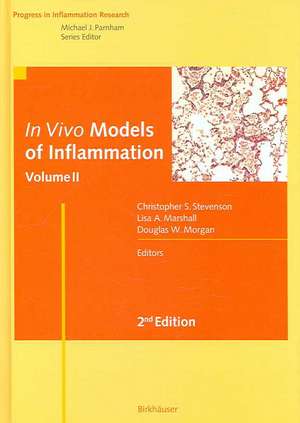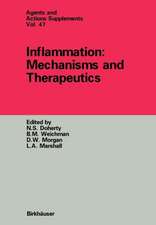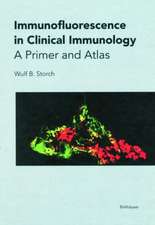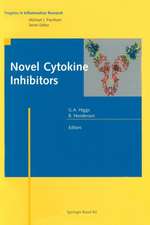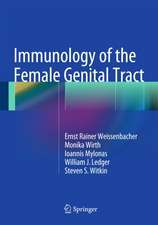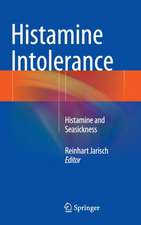In Vivo Models of Inflammation: Volume 2: Progress in Inflammation Research
Editat de Christopher S. Stevenson, Lisa A. Marshall, Douglas W. Morganen Limba Engleză Hardback – 15 sep 2006
Pioneering ideas and provocative comments about future directions are meant to challenge the status quo and stimulate new thinking. Therefore, new approaches to the development of future models in selected therapeutic areas have been highlighted. The focus on novel technologies that are vital for innovative in vivo research has been expanded to include chapters on the use of transgenic and gene transfer technologies, nanotechnology, and stem cells.
The aim of this set of books is to provide current best practices for obtaining the maximum information from in vivo experimentation, while preserving the dignity and comfort of the animal.
| Toate formatele și edițiile | Preț | Express |
|---|---|---|
| Hardback (2) | 1102.82 lei 6-8 săpt. | |
| Birkhäuser Basel – 15 sep 2006 | 1102.82 lei 6-8 săpt. | |
| Birkhäuser Basel – 15 sep 2006 | 1103.39 lei 6-8 săpt. |
Din seria Progress in Inflammation Research
- 5%
 Preț: 1615.04 lei
Preț: 1615.04 lei - 5%
 Preț: 1433.10 lei
Preț: 1433.10 lei - 5%
 Preț: 723.05 lei
Preț: 723.05 lei - 18%
 Preț: 950.21 lei
Preț: 950.21 lei - 15%
 Preț: 648.42 lei
Preț: 648.42 lei - 5%
 Preț: 1300.72 lei
Preț: 1300.72 lei - 5%
 Preț: 1103.95 lei
Preț: 1103.95 lei - 5%
 Preț: 1061.94 lei
Preț: 1061.94 lei - 5%
 Preț: 715.35 lei
Preț: 715.35 lei - 5%
 Preț: 1098.63 lei
Preț: 1098.63 lei - 5%
 Preț: 657.90 lei
Preț: 657.90 lei - 5%
 Preț: 717.93 lei
Preț: 717.93 lei - 5%
 Preț: 996.74 lei
Preț: 996.74 lei - 5%
 Preț: 1413.72 lei
Preț: 1413.72 lei - 5%
 Preț: 1102.46 lei
Preț: 1102.46 lei - 5%
 Preț: 991.73 lei
Preț: 991.73 lei - 5%
 Preț: 1115.86 lei
Preț: 1115.86 lei - 5%
 Preț: 720.31 lei
Preț: 720.31 lei - 5%
 Preț: 1611.76 lei
Preț: 1611.76 lei - 5%
 Preț: 654.23 lei
Preț: 654.23 lei - 5%
 Preț: 1414.64 lei
Preț: 1414.64 lei - 5%
 Preț: 652.77 lei
Preț: 652.77 lei - 5%
 Preț: 1099.94 lei
Preț: 1099.94 lei - 5%
 Preț: 1856.59 lei
Preț: 1856.59 lei - 15%
 Preț: 644.95 lei
Preț: 644.95 lei - 5%
 Preț: 1108.72 lei
Preț: 1108.72 lei - 5%
 Preț: 658.46 lei
Preț: 658.46 lei - 5%
 Preț: 1108.51 lei
Preț: 1108.51 lei - 24%
 Preț: 801.40 lei
Preț: 801.40 lei - 5%
 Preț: 715.19 lei
Preț: 715.19 lei - 5%
 Preț: 1807.08 lei
Preț: 1807.08 lei - 5%
 Preț: 721.40 lei
Preț: 721.40 lei - 5%
 Preț: 991.73 lei
Preț: 991.73 lei - 5%
 Preț: 720.68 lei
Preț: 720.68 lei - 5%
 Preț: 1100.09 lei
Preț: 1100.09 lei - 15%
 Preț: 577.87 lei
Preț: 577.87 lei - 5%
 Preț: 652.77 lei
Preț: 652.77 lei - 5%
 Preț: 653.35 lei
Preț: 653.35 lei - 5%
 Preț: 650.25 lei
Preț: 650.25 lei - 5%
 Preț: 1116.73 lei
Preț: 1116.73 lei - 5%
 Preț: 1096.98 lei
Preț: 1096.98 lei - 5%
 Preț: 1412.62 lei
Preț: 1412.62 lei - 5%
 Preț: 1420.49 lei
Preț: 1420.49 lei - 5%
 Preț: 721.77 lei
Preț: 721.77 lei - 5%
 Preț: 1102.10 lei
Preț: 1102.10 lei - 5%
 Preț: 1099.20 lei
Preț: 1099.20 lei
Preț: 1102.82 lei
Preț vechi: 1160.86 lei
-5% Nou
Puncte Express: 1654
Preț estimativ în valută:
211.05€ • 229.17$ • 177.28£
211.05€ • 229.17$ • 177.28£
Carte tipărită la comandă
Livrare economică 22 aprilie-06 mai
Preluare comenzi: 021 569.72.76
Specificații
ISBN-13: 9783764377571
ISBN-10: 3764377577
Pagini: 220
Ilustrații: X, 203 p. 19 illus.
Dimensiuni: 165 x 235 x 17 mm
Greutate: 0.63 kg
Ediția:2nd ed. 2006
Editura: Birkhäuser Basel
Colecția Birkhäuser
Seria Progress in Inflammation Research
Locul publicării:Basel, Switzerland
ISBN-10: 3764377577
Pagini: 220
Ilustrații: X, 203 p. 19 illus.
Dimensiuni: 165 x 235 x 17 mm
Greutate: 0.63 kg
Ediția:2nd ed. 2006
Editura: Birkhäuser Basel
Colecția Birkhäuser
Seria Progress in Inflammation Research
Locul publicării:Basel, Switzerland
Public țintă
ResearchCuprins
Asthma.- In vivo modeling systems for chronic obstructive pulmonary disease.- Murine models of allergen-induced airway hyperresponsiveness and inflammation.- Skin inflammatory disorders.- In vivo models of neurogenic inflammation.- Animal models of inflammatory bowel disease.- Preclinical models of vascular inflammation.
Textul de pe ultima copertă
In Vivo Models of Inflammation provides the biomedical researcher in both the pharmaceutical industry and academia with a description of the state of the art animal model systems used to emulate diseases with components of inflammation. This second edition acts as a complement to the first edition by describing and updating the standard models that are most utilized for specific disease areas. In addition, new models are included exploring emerging areas of inflammation research.
The format is designed with the laboratory in mind: Both volumes provide detailed descriptions of the methodologies and uses of the most significant models. This includes current information regarding agents that demonstrate efficacy, those that do not and those that can be used as standard controls. The focus remains on those models that serve as pre-clinical correlates to human disease as well as those that represent components of the inflammatory response.
Pioneering ideas and provocative comments about future directions are meant to challenge the status quo and stimulate new thinking. Therefore, new approaches to the development of future models in selected therapeutic areas have been highlighted. The focus on novel technologies that are vital for innovative in vivo research has been expanded to include chapters on the use of transgenic and gene transfer technologies, nanotechnology, and stem cells.
This up-to-date reference manual helps to select the best animal model for a specific question. At the same time, this set of books continues to acknowledge the solemn responsibility in vivo research carries with it and extends the coverage of animal respect and welfare when used in experimental settings. Chapters describing current regulations in the United States, United Kingdom, and Japan address these concerns.
Thus, the ultimate aim of this set of books is to provide current best practices for obtaining the maximum information from in vivo experimentation, while preserving the dignity and comfort of the animal.
The format is designed with the laboratory in mind: Both volumes provide detailed descriptions of the methodologies and uses of the most significant models. This includes current information regarding agents that demonstrate efficacy, those that do not and those that can be used as standard controls. The focus remains on those models that serve as pre-clinical correlates to human disease as well as those that represent components of the inflammatory response.
Pioneering ideas and provocative comments about future directions are meant to challenge the status quo and stimulate new thinking. Therefore, new approaches to the development of future models in selected therapeutic areas have been highlighted. The focus on novel technologies that are vital for innovative in vivo research has been expanded to include chapters on the use of transgenic and gene transfer technologies, nanotechnology, and stem cells.
This up-to-date reference manual helps to select the best animal model for a specific question. At the same time, this set of books continues to acknowledge the solemn responsibility in vivo research carries with it and extends the coverage of animal respect and welfare when used in experimental settings. Chapters describing current regulations in the United States, United Kingdom, and Japan address these concerns.
Thus, the ultimate aim of this set of books is to provide current best practices for obtaining the maximum information from in vivo experimentation, while preserving the dignity and comfort of the animal.
Caracteristici
Revised and extended 2nd edition of this reference manual in two volumes New models from emerging areas of research have been added Provides detailed descriptions of the methodologies and uses of the most significant animal models Includes supplementary material: sn.pub/extras
